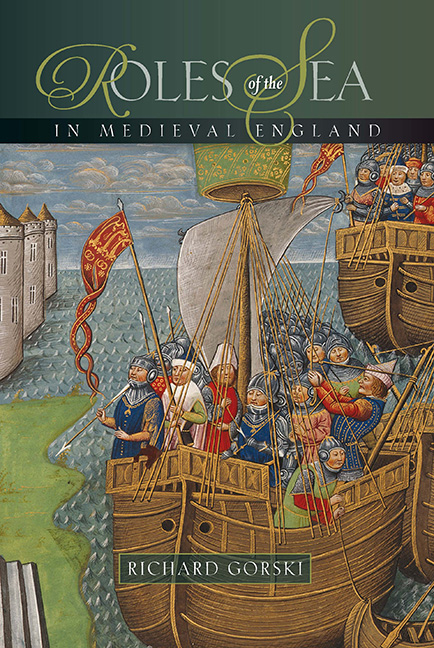Book contents
- Frontmatter
- Contents
- List of Contributors
- Map
- 1 Roles of the Sea: Views from the Shore
- 2 Changes in Ship Design and Construction: England in the European Mould
- 3 The Value of the Cinque Ports to the Crown 1200–1500
- 4 The Contribution of the Cinque Ports to the Wars of Edward II and Edward III: New Methodologies and Estimates
- 5 Keeping the Seas: England's Admirals, 1369–1389
- 6 The Cost-Benefit Analysis of a Fourteenth-Century Naval Campaign: Margate/Cadzand, 1387
- 7 Piracy and Anglo-Hanseatic Relations, 1385–1420
- 8 ‘Herring of Sligo and Salmon of Bann‘: Bristol's Maritime Trade with Ireland in the Fifteenth Century
- 9 How Much did the Sea Matter in Medieval England 167 (c.1200–c.1500)?
- Index
2 - Changes in Ship Design and Construction: England in the European Mould
Published online by Cambridge University Press: 05 September 2016
- Frontmatter
- Contents
- List of Contributors
- Map
- 1 Roles of the Sea: Views from the Shore
- 2 Changes in Ship Design and Construction: England in the European Mould
- 3 The Value of the Cinque Ports to the Crown 1200–1500
- 4 The Contribution of the Cinque Ports to the Wars of Edward II and Edward III: New Methodologies and Estimates
- 5 Keeping the Seas: England's Admirals, 1369–1389
- 6 The Cost-Benefit Analysis of a Fourteenth-Century Naval Campaign: Margate/Cadzand, 1387
- 7 Piracy and Anglo-Hanseatic Relations, 1385–1420
- 8 ‘Herring of Sligo and Salmon of Bann‘: Bristol's Maritime Trade with Ireland in the Fifteenth Century
- 9 How Much did the Sea Matter in Medieval England 167 (c.1200–c.1500)?
- Index
Summary
The technology of shipbuilding went through a long evolution from late Antiquity to the sixteenth century. The voyages of discovery that took Renaissance Europeans around the world and back again were not possible in the Roman era but they were by 1492 thanks to a long string of changes in the ships that came from European yards. The development was marked by fits and starts, by sudden jumps and then extended periods of stability. English shippers were beneficiaries of those changes. The voyages of exploration of the Venetian John Cabot, sponsored by the king of England, in 1497 and 1498, and whatever similar voyages from Bristol that may have preceded his are an obvious indication of how England participated in the European development of ships through to the end of the Middle Ages. Typically followers and rarely at the ‘cutting edge’ of technical advance, English shipbuilders functioned very much within the context of general European design improvements. The advances made in England, often borrowed from elsewhere around the Mediterranean Sea or from types utilised in the North and Baltic Seas, had roots similar to those that shaped technical change in other parts of Europe. The major differences in how shipwrights constructed their ships and the unique evolution in European ship design had many different causes, the factors varying widely over time and space. A definite and precisely delimited answer to why technical change occurred, and why it occurred as it did, remains elusive. Still, certain features of society, of general knowledge, of culture, of politics and political structures, and of the economy at varied points all but certainly influenced what shipbuilders did. In some cases simple arguments about the importance of the costs of inputs appear to remain valid while more often the explanations for technical advances appear more muddled and complex. Being able to identify influences on ship design reflects a growing and presumably deeper understanding of the nature and variety of medieval European society. England was no exception, and though English shipbuilders may have been late adopters of many technical advances the pattern in the island kingdom was one shared with the rest of Europe. It is that larger framework that set the stage for technical change in English shipbuilding and shipping and so made possible the role which the sea played in medieval English society.
- Type
- Chapter
- Information
- Roles of the Sea in Medieval England , pp. 25 - 40Publisher: Boydell & BrewerPrint publication year: 2012

